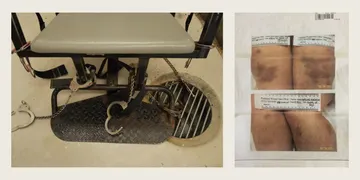In October, over a hundred prominent police commissioners and prosecutors issued an unprecedented call for ending mass incarceration, stating, “We believe unnecessary incarceration does not work to reduce crime, wastes taxpayer dollars, damages families and divides communities.”
As someone who has run correctional agencies in two major American cities, I share their concern. But I want to add one point to their message: in order to truly end mass incarceration in this country, we can’t forget about the kids.
Specifically, we need to completely shutter the doors of youth prisons, which confine 54,000 juveniles. If juvenile corrections were one prison system, it would be the fifth largest in the U.S. with a juvenile incarceration rate five to 10 times higher than most Western nations.
I saw the harm of youth prisons firsthand when I ran a facility in Washington, D.C. It was a Dickensian nightmare. Staff routinely beat the kids, sold them drugs, and, occasionally, sexually assaulted them. Youth frequently complained of rats and cockroaches in their rooms at night. They were locked into their cells for so long that they often urinated or defecated in them.
A visit to the Justice Department website reveals scores of hair-raising accounts of institutional abuses from around the country. Two of them are in New York State’s juvenile system and the adolescent unit in New York City’s jail – Rikers Island. In both systems, Justice Department investigators found conditions chillingly similar to what I found in Washington’s system, including excessive use of force and isolation, inadequate educational and mental health services, and a culture of violence.
According to the Annie E. Casey Foundation, one of the nation’s leading juvenile justice philanthropies, systemic violence, abuse, and excessive use of isolation and restraints have been documented since 1970 in juvenile institutions in 39 states, the District of Columbia, and Puerto Rico. During that time, 57 lawsuits in these jurisdictions resulted in court-sanctioned remedies.
These atrocities are not meted out equally, with African Americans and Latinos incarcerated at far higher rates than whites. In my five years running the Washington system, I never saw one white youth (other than volunteers) in my correctional facility.
Perhaps worst of all, these inhumane conditions do nothing to improve public safety or put youth on the right track. Not surprisingly, the Casey foundation reported that juvenile incarceration makes adult imprisonment more likely, and locking up low-risk youth actually increases their recidivism.
This data led Casey president and former youth corrections commissioner Patrick McCarthy to exclaim “I believe it’s long past time to close these inhumane, ineffective, wasteful factories of failure once and for all. Every one of them.”
Fortunately, some places have found alternatives to locking up kids, and New York is a good example.
In 2006, the city created a screening tool to ensure low- and medium-risk youth found alternatives to detention while their cases were pending. That, and some rigorous community programs for “committed” youth (the juvenile system’s euphemism for “incarcerated”), helped reduce the number of kids in state lockups by about two-thirds.
As a result, recidivism rates, no matter their risk for reoffense, fell considerably. But officials still felt more needed to be done.
So Mayor Michael Bloomberg — no softie on crime — joined forces with Gov. Andrew Cuomo to enact Close to Home legislation that would house all New York City youth — who were sentenced in family court — in locations closer to their communities (rather than large, distant state institutions). "The current system is not helping kids, it isn’t helping taxpayers and it isn’t helping public safety,” Bloomberg said. Close to Home passed in 2012 with bipartisan support.
Since the enactment of Close to Home, the number of juveniles placed into custody has dropped by 53 percent, while juvenile arrests in the city have declined by half.
Here’s what all those serious about ending mass incarceration need to know: there is a lot to learn from the juvenile justice system. For all its imperfections, the family court tries to individualize care, divert lawbreakers into community programs, and rehabilitate young people, while mostly sheltering them from a lifetime of collateral consequences.
Perhaps that’s why, from 2001 to 2013, there has been a 53 percent decline in the number of juveniles incarcerated in America, while the adult incarceration rate rose slightly. Forty-eight states had double-digit declines in youth incarceration during this period, and our five largest states experienced drops of nearly two-thirds. These significant declines have not come at the expense of public safety; in 2012, the juvenile violent crime rate reached a historic low.
As we’re rightly fighting to end mass incarceration, we need to remember the kids. America’s “reform schools” mete out anything but reform and should be relegated to history’s dustbin. Conditions in my facility poisoned staff and kids alike, and harmed, rather than improved, public safety. States would be wise to follow Patrick McCarthy’s advice and New York City’s example, and close their youth prisons in favor of strong community programs and small, decent facilities near home.
Vincent Schiraldi directed juvenile corrections for Washington, D.C. and was Commissioner of Probation and Senior Advisor to the Mayor’s Office of Criminal Justice in New York City. He is now Senior Research Fellow at Harvard Kennedy School’s Program in Criminal Justice.
